
In this article:
I can’t say for certain that juicing is the key to health and longevity. But it’s worth noting that famed nutrition guru and father of the modern juice movement, Jack LeLanne, lived to be 96. I mean, there’s gotta be some reason “juice” is slang for energy, right? Buying fresh juice from a juice shop can cost a pretty penny, but juicing at home is easy and far less costly. The best juicers squeeze the ever-lovin’ heck out of healthy fruits and vegetables, no matter how dense they are. For certain superfoods, a mechanical juicer is the only practical way to get those liquid benefits to gulp down. Just try putting a beet into a handheld citrus juicer — we’ll wait.
Centrifugal juicers, which are considered traditional or entry-level juicers, produce strained juice in seconds as blades spin at high speeds to chop your produce and push it through a mesh sieve. Centrifugal machines can be loud and messy, but fresh juice seems like a fair trade. There are also masticating juicers sometimes referred to as “cold press” juicers. These cost more but extract more nutrients from whatever is thrown inside via augers that squeeze the juice from the pulp versus whipping it around as with centrifugal juicers.
Read more: 8 Do’s and Don’ts for Juicing at Home
In testing to find the best juicer for 2023, we keyed in on each model’s overall functionality and intuitiveness, how easy the juicer is to clean (you’ll want to clean them after every use) and, most importantly, how much juice you get from a given pile of fresh produce. The best juicer should also have a big enough feed tube for even larger hunks of fruits, roots and vegetables. Even if you’re only planning to juice citrus fruit for cocktails or launch into a trendy celery juice cleanse, there are a lot of excellent juicer options out there to help you along.
If you’re ready to become the super-juicer you were always meant to be, we tested several models to find the best juicer for 2023.
Best juicers for 2023
Molly Price/CNET
It’s not often that one of the best in a series of products we test also happens to be one the most affordable, but we sure do get excited when it does. Hamilton Beach’s Big Mouth juicer was the best overall performer when it came to getting maximum juice from citrus juice from oranges and green juice from kale (a wildly popular juicing green). This 800-watt juicer had been out of stock for months but it’s back. The Big Mouth has one speed; every other juicer we tested was a twin-gear juicer and had at least two speeds, but we didn’t find that necessary.
At just $70, the Big Mouth also wears the crown for best budget juicer when you want to juice fruit and leafy vegetables but minimize upfront costs. It’s dishwasher-safe, too, which is as important as juice quality in my opinion. Our only complaint is that the Big Mouth doesn’t come with a juice receptacle to place beneath the spout.
You’re receiving price alerts for Hamilton Beach Juicer Machine, Big Mouth Large 3” Feed Chute for Whole Fruits and Vegetables, Easy to Clean, Centrifugal Extractor, BPA Free, 800W Motor, Black
Molly Price/CNET
True to Breville form, this vertical juicer feels high-end, is solidly built, easy to use and looks great. The Breville JE98XL was a very close second for best overall juicer, just a hair behind the Hamilton Beach Big Mouth when it came to performance. The Breville performed exceptionally well in all juicing tests but delivered the best apple juice yield of the juicers we used.
At $180, This two-speed, 850-watt Breville juicer is more of a splurge, but it comes with a few nice features. In addition to the powerful centrifugal juicer, you’ll get a 1-liter juice pitcher made from high-grade plastic and a “froth separator” which we found extremely useful since it keeps the frothy top layer of your juice retained while you pour out the good stuff. As with all the juicers on our list, you’ll also get a brush for cleaning out the mesh sieve basket inside the juicer.
You’re receiving price alerts for Breville JE98XL Juice Fountain Plus
Molly Price/CNET
Oster’s JusSimple juicer was easy to use and easy to clean and is our pick for best design. The sporty red coating on the filter makes it easier to clean out than most other models which are uncoated. A convenient rotating spout with open and closed positions keeps the juice from dripping on your countertop from the feed chute.
The JusSimple also has a wide, 3-inch mouth, so you’ll do less chopping to fit your produce into the juicer. A lighted speed dial adds to the sophistication of this model. While it didn’t give us the best results (the Oster came in fourth of eight), it was a pleasure to use and I’d be happy to give it a permanent home on my countertop if it were on sale.
You’re receiving price alerts for Oster JusSimple Easy Juicer (FPSTJE9010000)
Other models
We rounded up the best juicers above, but tested 10 juicers in total. Here are the other five models:
- Hurom Horizontal Slow Juicer: This slow juicer is designed specifically for greens and celery. It performed extremely well in our kale test and won’t disappoint but the $335 price keeps it out of the top spots.
- Nutribullet: This affordable juicer did a fine job at its main function, getting out the juice, but it wasn’t our favorite to use and there was some leaking during use.
- Kuvings NJ Series Centrifugal Juicer: This juice was our third-place winner when it came to juice extraction. It’s a bit on the expensive end at $150, but a good bet if you ever see it on sale.
- Bagotte DB-001: At $60, this juicer is a budget model that can get the job done.
- Mueller Ultra-Power Juicer: This 1,100-watt juicer was too average in performance to warrant its $90 price, but you can frequently find it on sale for about $70.
- Black & Decker JE2200B: This juicer was our worst performer, but it is an affordable way to try your hand at juicing for about $50.
Cuisinart CJE-1000: This looks great, but performed poorly. It’s also a steep $180.
How we tested juicers
Testing juicers means, well, juicing. We gathered up heaps of apples and oranges and bunches of kale to see how these juicers handled produce of varying texture and density.
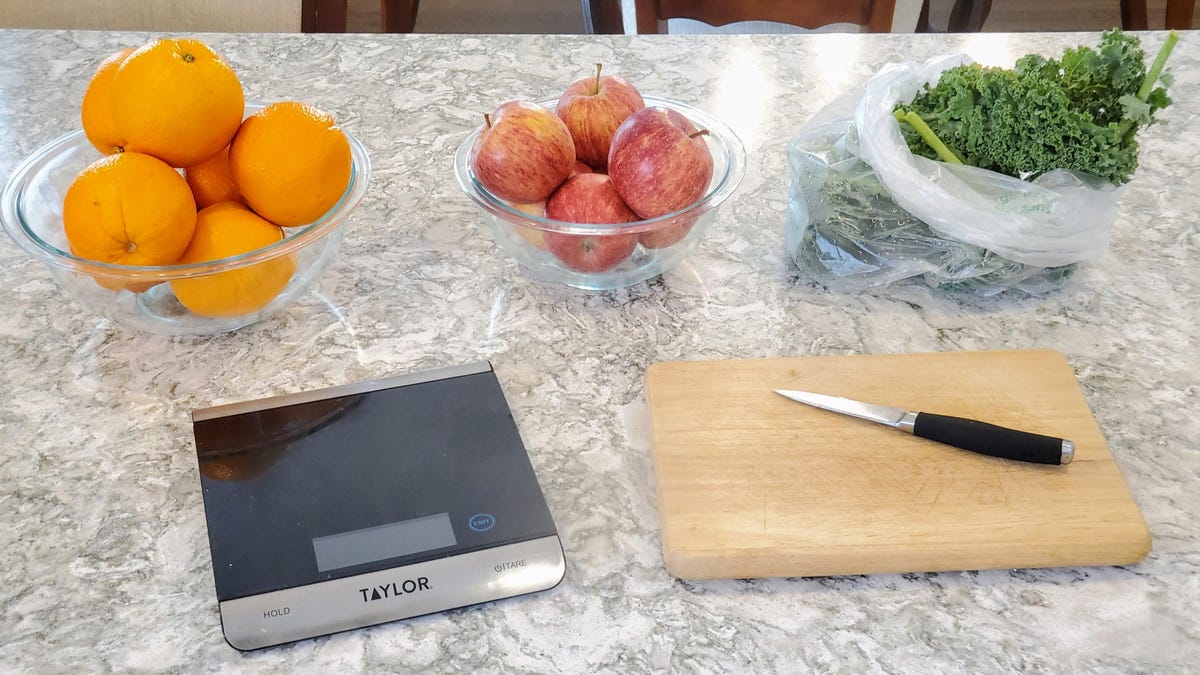
I tested the juicers with oranges, apples and kale.
CNET
Apples
To test the juicer’s high-speed function, we cored and quartered three red apples. (We used organic Gala apples in this round of testing.) Next, we weighed the apples, the empty juice receptacle and the empty juicer on a large kitchen scale. Then, we juiced the apples on the juicer’s high setting or, if there were multiple speeds, the manual’s recommended apple speed.
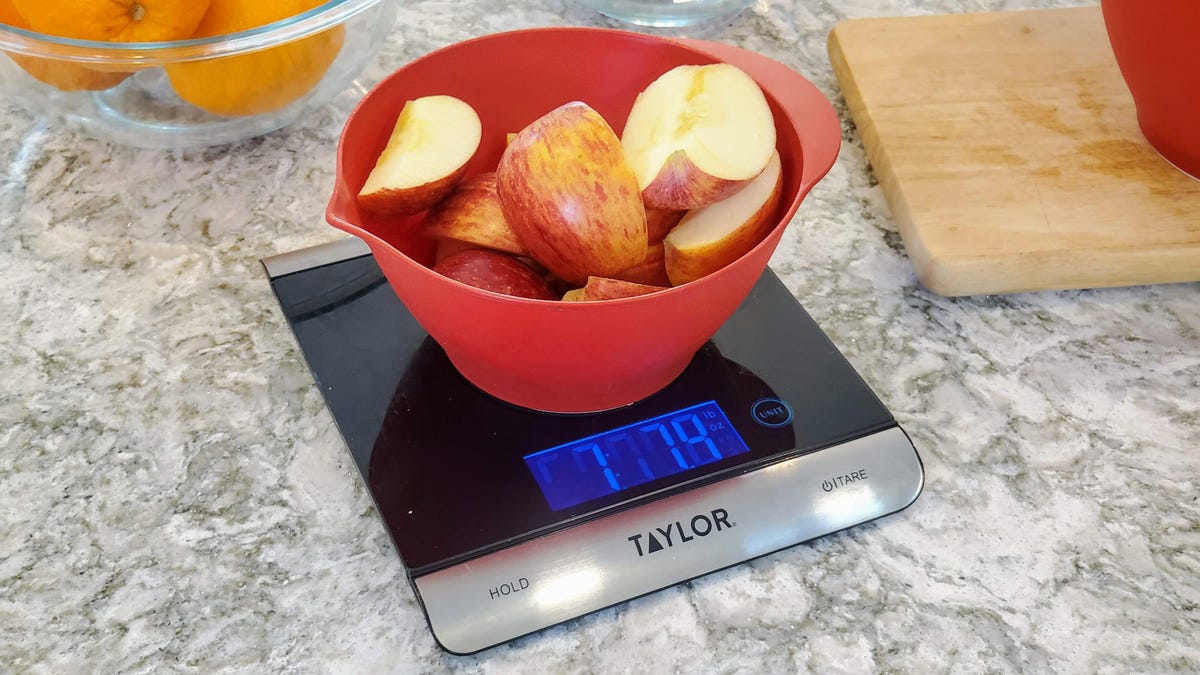
Want to make delicious apple juice?
CNET
The result was a pink juice with a light brown pulp. Once juicing was complete, we measured the filled juice receptacle and the juicer with its apple waste to determine just how much juice came out of the apples and how much of the apple ended up in the pulp container. This is the same method we used for oranges and kale.
Oranges
We peeled three navel oranges and removed the fibrous center pulp. Next, we measured them along with the empty juicer and juice receptacle. Depending on the juicer’s chute size, we also trimmed down the oranges into wedges that fit the chute.
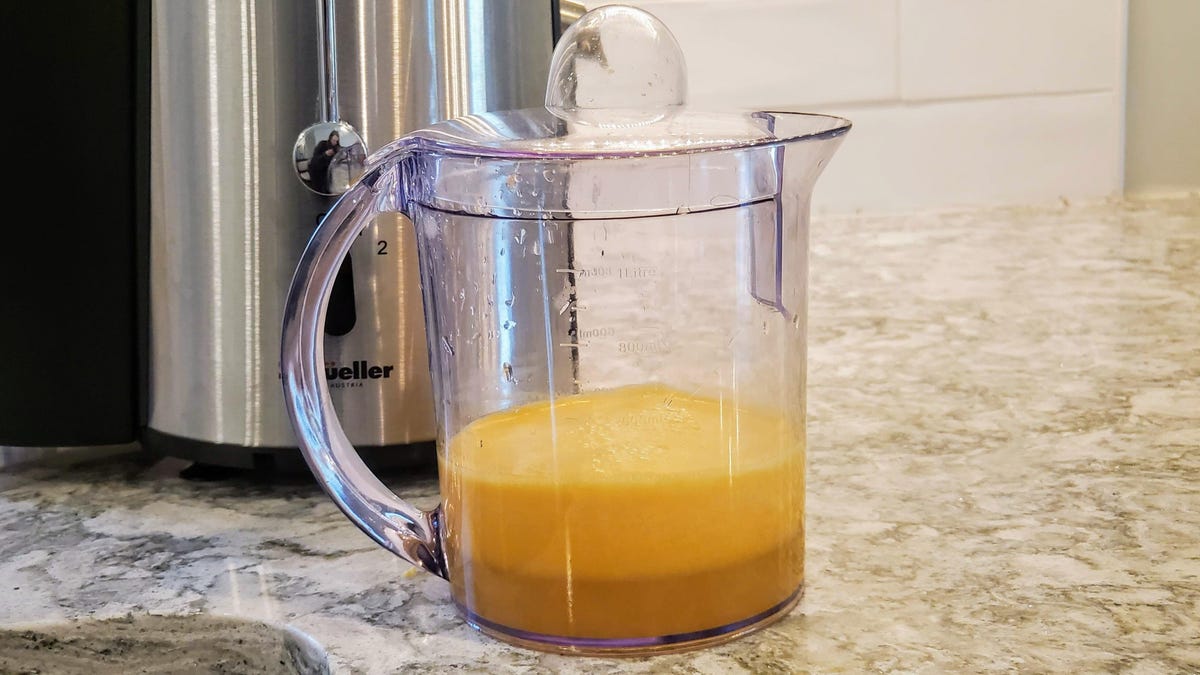
Fresh orange juice can be extra-frothy.
CNET
For orange juicing, we set the juicer to its low speed, a good setting for soft fruit like oranges. Once the juicer was finished, we weighed everything again and took notes.
Kale
Juicer testing wouldn’t be complete without a leafy green element. It’s worth noting here that most centrifugal juicers won’t do as well as a cold-press juicer (aka a slow-masticating juicer) for extracting juice from greens. Still, it is possible and some centrifugal juicers are up to the task.
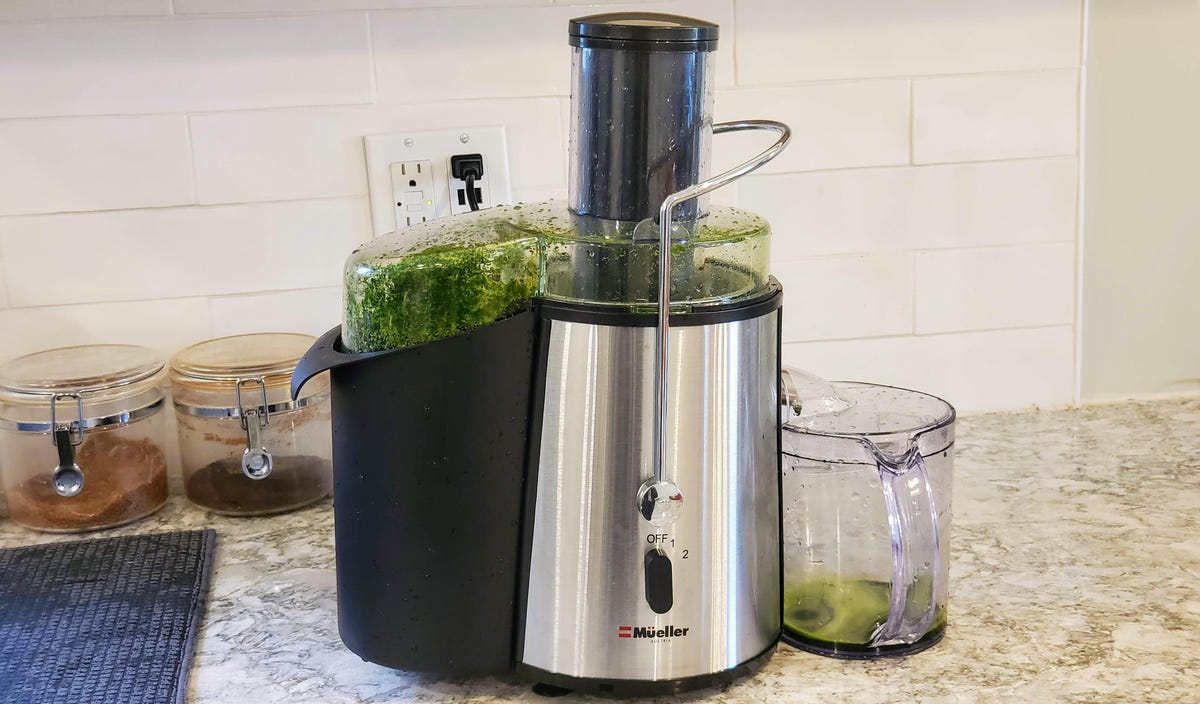
Kale juicing is certainly colorful.
CNET
As in the apple and orange juice tests, we measured and recorded the weight of the equipment, as well as three large kale leaves. (It’s not necessary to trim here; kale stems have plenty of nutritional value and will go through the juicer.) We did see much less volume when it came to kale juice. So if you’re keen on juicing leafy items, a masticating juicer might be a better bet for you.
Best juicers compared
| Brand | % orange juice extracted | % apple juice extracted | % kale juice extracted |
|---|---|---|---|
| Bagotte | 70.07% | 67.20% | 22.86% |
| Black & Decker | 61.83% | 63.47% | 16.25% |
| Breville | 72.26% | 75.61% | 38.76% |
| Cuisinart | 67.72% | 62.05% | 17.94% |
| Hamilton Beach | 76.55% | 65.31% | 39.19% |
| Hurom | 72.45% | 71.23% | 41.10% |
| Kuvings | 73.46% | 72.25% | 23.83% |
| Mueller Austria | 71.91% | 59.73% | 23.17% |
| Nutribullet | 69.34% | 70.00% | 24.56% |
| Oster | 76.23% | 63.38% | 28.09% |
Things to consider when buying a juicer
Centrifugal juicers are fine for processing oranges, apples and many other fruits and vegetables. When it comes to greens, a centrifugal juicer won’t be your best bet. It’s important to think about what you’ll be juicing most frequently.
We consider other factors besides weight data in all three tests, too. Choosing a juicer with a wide mouth of around 3 inches in diameter will make your life easier. A wide mouth will significantly cut down on the amount of prep you need to do before you juice. We’re also a big fan of included juice pitchers with froth separators, especially if you like pulp-free juice.
Other handy extra features include brushes (most juicers include one) as well as a cap to cover the spout and suction cups on the juicer’s base to hold it steady on your counter.
The uses for fresh juice made in a juicer go beyond a healthy liquid breakfast or midday snack. See the frozen juice pops below we made with leftovers as proof.
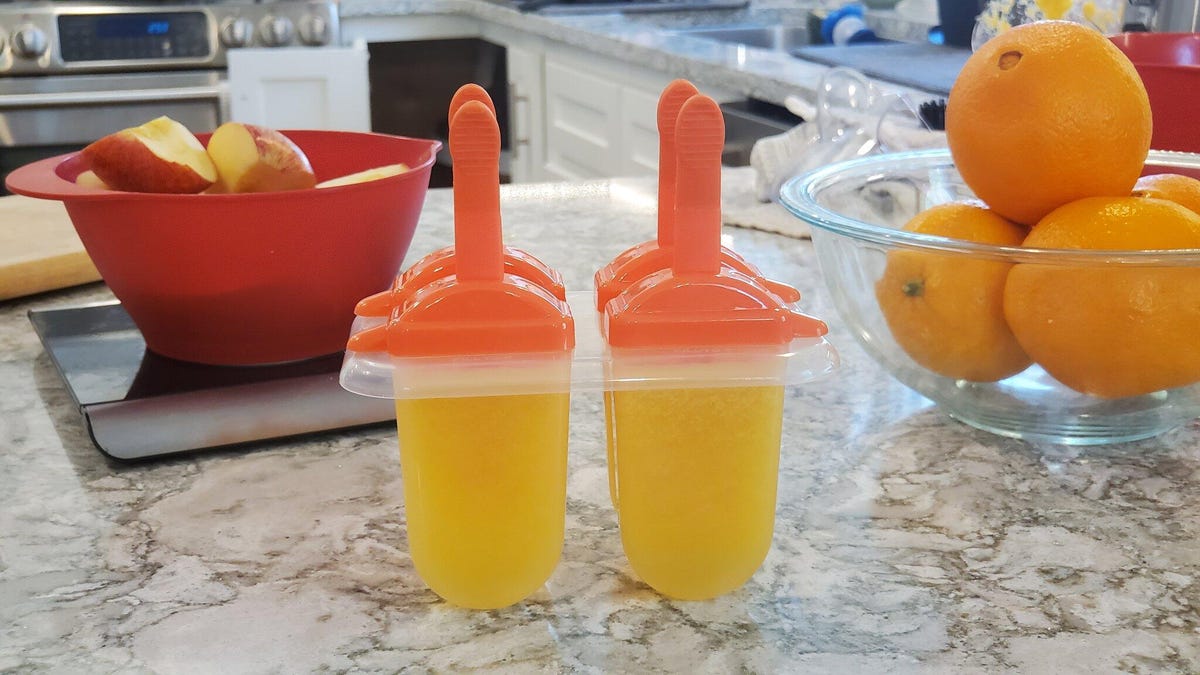
Orange ice pops just waiting for summer.
CNET
How do you clean a juicer?
- You should clean your juicer after each every. Thankfully, modern juicers are easy to wash and many are dishwasher-safe. You’ll want to power down your juicer and disassemble the parts.
- Empty the pulp bin into the garbage or compost bin and place all the detached parts in the sink with soapy water. You can let them sit for a few minutes or wash them down with a soft sponge.
- You’ll also want to wipe the base with a wet sponge and a little soap, if necessary. Try to not get any parts of the motor wet if they happen to be exposed.
- After all the detachable parts of the juicer have fully dried, reassemble the juicer and store it away the next time.
Is there anything you shouldn’t put in a juicer?
There are plenty of fruits and vegetables that either don’t make sense to juice or shouldn’t be juiced for other reasons. Avocados and bananas, for instance, are not good for juicing since they contain very little juice and avocados, specifically, are rather expensive.
Cruciferous vegetables such as cauliflower and broccoli are not great candidates for juicing, either, since they can be difficult to digest in a raw, concentrated form.
And resist the urge to add ice to your juicer. It’s not meant for making smoothies and ice could damage the motor. For that, try one of these excellent blenders instead.
Is juicing actually good for you?
For the most part, yes, but if you lean too heavily on high-in-sugar fruits for your juicing routine, you might be doing more harm than good. The healthiest way to juice is by combining healthy greens, beets, ginger, carrots and other nutrient-rich vegetables with the occasional chunk of pineapple or half an apple to sweeten the deal.




